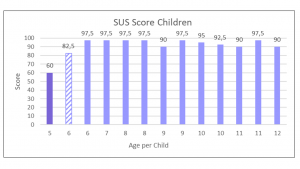Evaluation of the usability of an interactive hearing training integrating a robot ball and a smart assistant for children with cochlea implants
Aim and Research Question(s)
The aim of this master's thesis was to evaluate the interactive auditory training "Coch-LEA: A Listening Exercise Adventure" for children with cochlea implants. It was asked if Coch-LEA is appealing to children, aged 5-12, if it raises their interest, if they can use it independently and if they would use it several times.
Background
Worldwide about 466 million people suffer from hearing loss. 34 million of them are children meaning that 1-2 in 1000 children are born deaf [1].
Often these children are then fitted with cochlea implants (CI). To make it easier for CI users to learn to process and translate the electrical stimulation, they are advised to undergo auditory training [2].
Therefore, the auditory training Coch-LEA was developed. It consists of an Amazon Alexa Skill, the Sphero robot ball and a playground.
 Figure1: Coch-LEA function
Figure1: Coch-LEA function
Methods
The participants consisting of 11 experts (pedagogues and therapists) and 13 children with normal hearing were asked to play two levels of Coch-LEA: "sound detective" and "syllable magic". After that a qualitative usability analysis of Coch-LEA was conducted. KIM (Kurzskala intrinsischer Motivation) and SUS (System Usability Scale) were used for this purpose. In addition a specially designed expert questionnaire was used for the experts and a guided interview was chosen for the children.
Results and Discussion
 Figure 2: SUS score children
Figure 2: SUS score children
The SUS score was rated averagely high by both groups: experts 86, children 91. As seen in the diagram, the youngest participant (5 a), scored Coch-LEA significantly lower.
Through KIM, it could be determined that the intrinsic motivation is addressed by Coch-LEA and that the experts and the children had fun with the auditory training and would play it more often.
The overall rating of Coch-LEA in the expert questionnaire showed that the expectations of this new interactive auditory training were met and that it could be used additional to classical auditory training.
Conclusion
This study shows that the interactive auditory training Coch-LEA is appealing to children between the ages of 6 and 11: Coch-LEA catches their interest, from school age the children also feel able to use it themselves and in case more levels are added, they would use it more often. In order to achieve even more meaningful results, this study should be continued with the actual target group. Both children with CI and their parents should use similar methods to evaluate Coch-LEA.
References
[1] WHO. (2021). Deafness and hearing loss. [2] University of Maryland Medical Center. (2022). Cochlear Implants.